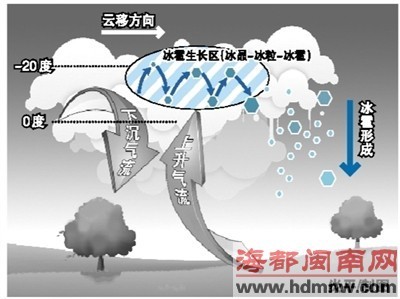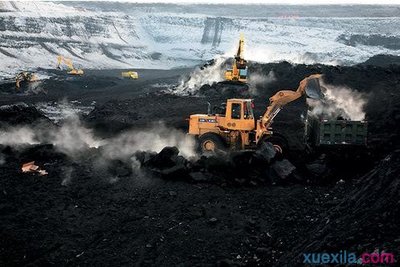冬季,大雪纷飞,苍茫无际。雪花是怎么形成的呢?用英语如何解释呢?爱华网小编在此整理了雪花形成的原因中英文,供大家参阅,希望大家在阅读过程中有所收获!

雪花形成原因(汉语篇)
雪花是由小冰晶增大变来的,而冰的分子以六角形的为最多,因而形成雪花多是六角形的,并且每一片雪花的形状没有一模一样的。雪花形状的多种多样,则与它形成时的水汽条件有密切的关系。
对于六角形片状冰晶来说,由于它面上、边上和角上的弯曲程度不同,相应地具有不同的饱和水汽压,其中角上的饱和水汽压最大,边上次之,平面上最小。在实有水汽压相同的情况下,由于冰晶的面、边、角上的饱和水汽压不同,其凝华增长的情况也不相同。如果云中水汽不太丰富,实有水汽压仅大于平面的饱和水汽压,水汽只在面上凝华,这时形成的是柱状雪花;如果水汽稍多,实有水汽压大于边上的饱和水汽压,水汽在边上和面上都会发生凝华,由于凝华的速度还与弯曲程度有关,弯曲程度大的地方凝华较快,所以在冰晶边上凝华比面上快,这时多形成片状雪花;如果云中水汽非常丰富,实有水汽压大于角上的饱和水汽压,这样在面上、边上、角上都有水汽凝华,但尖角处位置突出,水汽供应最充分,凝华增长得最快,所以多形成枝状或星状雪花,故又名六出。
再加上冰晶不停地运动,它所处的温度和湿度条件也不断变化,这样就使得冰晶各种部分增长的速度不一致,形成多种多样的雪花。
雪花形成原因(英语篇)Snowflakes nucleate around mineral or organic particles in moisture-saturated, subfreezing air masses. They grow by net accretion to the incipient crystals in hexagonal formations. The cohesive forces are primarily electrostatic.
Nucleus
In warmer clouds an aerosol particle or "ice nucleus" must be present in (or in contact with) the droplet to act as a nucleus. The particles that make ice nuclei are very rare compared to nuclei upon which liquid cloud droplets form; however, it is not understood what makes them efficient. Clays, desert dust and biological particles may be effective, although to what extent is unclear. Artificial nuclei include particles of silver iodide and dry ice, and these are used to stimulate precipitation in cloud seeding.[4] Experiments show that "homogeneous" nucleation of cloud droplets only occurs at temperatures lower than −35 °C (−31 °F).
Growth[edit]
Once a droplet has frozen, it grows in the supersaturated environment, which is one where air is saturated with respect to ice when the temperature is below the freezing point. The droplet then grows by deposition of water molecules in the air (vapor) onto the ice crystal surface where they are collected. Because water droplets are so much more numerous than the ice crystals due to their sheer abundance, the crystals are able to grow to hundreds of micrometers or millimeters in size at the expense of the water droplets. This process is known as the Wegener–Bergeron–Findeisen process. The corresponding depletion of water vapor causes the droplets to evaporate, meaning that the ice crystals grow at the droplets' expense. These large crystals are an efficient source of precipitation, since they fall through the atmosphere due to their mass, and may collide and stick together in clusters, or aggregates. These aggregates are usually the type of ice particle that falls to the ground. Guinness World Records list the world's largest (aggregate) snowflakes as those of January 1887 at Fort Keogh, Montana; allegedly one measured 15 inches (38 cm) wide. Although this report by a farmer is doubtful, aggregates of three or four inches width have been observed. Single crystals the size of a dime (17.91 mm in diameter) have been observed. Snowflakes encapsulated in rime form balls known as graupel.
Cohesion
The exact details of the sticking mechanism remain controversial. Possibilities include mechanical interlocking, sintering, electrostatic attraction as well as the existence of a "sticky" liquid-like layer on the crystal surface. The individual ice crystals often have hexagonal symmetry. Although the ice is clear, scattering of light by the crystal facets and hollows/imperfections mean that the crystals often appear white in color due to diffuse reflection of the whole spectrum of light by the small ice particles. The shape of the snowflake is determined broadly by the temperature and humidity at which it is formed. Rarely, at a temperature of around −2 °C (28 °F), snowflakes can form in threefold symmetry — triangular snowflakes. The most common snow particles are visibly irregular, although near-perfect snowflakes may be more common in pictures because they are more visually appealing. It is unlikely that any two snowflakes are alike due to the estimated 1019 (10 quintillion) water molecules which make up a typical snowflake,[8] which grow at different rates and in different patterns depending on the changing temperature and humidity within the atmosphere that the snowflake falls through on its way to the ground.
Symmetry
A non-aggregated snowflake often exhibits six-fold radial symmetry. The initial symmetry can occur because the crystalline structure of ice is six-fold. The six "arms" of the snowflake, or dendrites, then grow independently, and each side of each arm grows independently. Most snowflakes are not completely symmetric. The micro-environment in which the snowflake grows changes dynamically as the snowflake falls through the cloud, and tiny changes in temperature and humidity affect the way in which water molecules attach to the snowflake. Since the micro-environment (and its changes) are very nearly identical around the snowflake, each arm can grow in nearly the same way. However, being in the same micro-environment does not guarantee that each arm grow the same; indeed, for some crystal forms it does not because the underlying crystal growth mechanism also affects how fast each surface region of a crystal grows.Empirical studies suggest less than 0.1% of snowflakes exhibit the ideal six-fold symmetric shape. Very occasionally twelve branched snowflakes are observed; they maintain the six-fold symmetry.
 爱华网
爱华网



